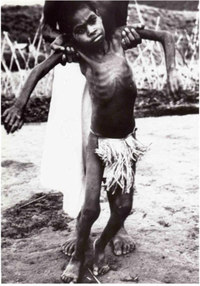KURU DISEASE
Kuru is a very rare, incurable neurodegenerative disorder that was formerly common among the Fore people of Papua New Guinea. Kuru is caused by the transmission of abnormally folded prion proteins, which leads to symptoms such as tremors, loss of coordination, and neurodegeneration.
The term kuru derives from the Fore word kuria or guria ("to shake"),[1] due to the body tremors that are a classic symptom of the disease and kúru itself means "trembling".[2] It is also known as the "laughing sickness" due to the pathologic bursts of laughter which are a symptom of the disease. It is now widely accepted that kuru was transmitted among members of the Fore tribe of Papua New Guinea via funerary cannibalism. Deceased family members were traditionally cooked and eaten, which was thought to help free the spirit of the dead.[3] Women and children usually consumed the brain, the organ in which infectious prions were most concentrated, thus allowing for transmission of kuru. The disease was therefore more prevalent among women and children.
The epidemic likely started when a villager developed sporadic Creutzfeldt–Jakob disease and died. When the women ate the brain, they caught the disease, and then the people that ate them caught it, and on it went.[4]
While the Fore people stopped eating human meat in the early 1960s, when it was first speculated to be transmitted via endocannibalism, the disease lingered due to kuru's long incubation period of anywhere from 10 to over 50 years.[5] The epidemic declined sharply after discarding cannibalism, from 200 deaths per year in 1957 to 1 or no deaths annually in 2005, with sources disagreeing on whether the last known kuru victim died in 2005 or 2009.[
HILLARY CLINTON KURU DISEASE
CRITICAL INFORMATION: Kuru disease is known as the “laughing sickness” due to the pathological bursts of laughter which are a symptom of the disease.
What are the symptoms of kuru?
- - difficulty walking
- - poor coordination
- - difficulty swallowing
- - slurred speech
- - moodiness and behavioral changes
- - dementia
- - muscle twitching and tremors
- - inability to grasp objects
- - random, compulsive laughing or crying
What are the causes of kuru?
Kuru belongs to a class of diseases called transmissible spongiform encephalopathies (TSEs), also called prion diseases. It primarily affects the cerebellum — the part of your brain responsible for coordination and balance. Unlike most infections or infectious agents, kuru is not caused by a bacteria, virus, or fungus. Infectious, abnormal proteins known as prions cause kuru. Prions are not living organisms and do not reproduce. They are inanimate, misshapen proteins that multiply in the brain and form clumps, hindering normal brain processes.
You can contract the disease by eating an infected brain or coming into contact with open wounds or sores of someone infected with it. Kuru developed primarily in the Fore people of New Guinea when they ate the brains of dead relatives during funeral rites. Women and children were mainly infected because they were the primary participants in these rites.[
https://www.disclose.tv/diagnosis-hillary-clinton-may-have-kuru-disease-307742
https://medium.com/@TheLightArk/hillary-clinton-kuru-disease-from-pizzagate-b8808a215b4a















No comments:
Post a Comment